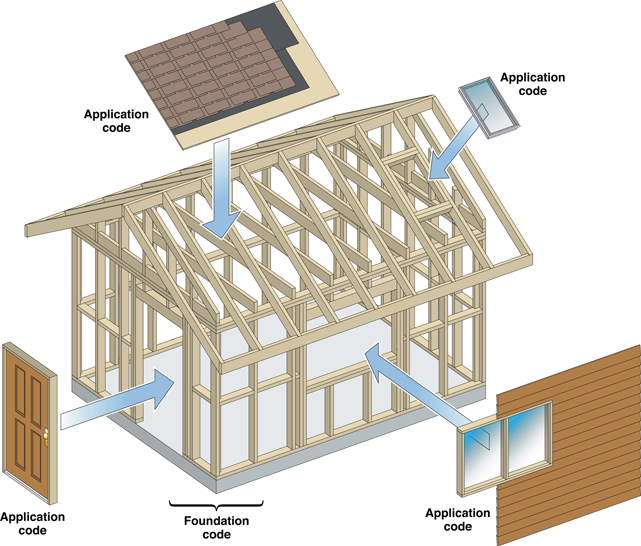Building Object Oriented Frameworks (1)


 What are object-oriented frameworks? Object oriented frameworks are a mainstay of modern software development. Whether you develop in Java, C#, Objective-C, Python, Ruby or Javascript, chances are you’re basing your development on some sort of application development framework.
What are object-oriented frameworks? Object oriented frameworks are a mainstay of modern software development. Whether you develop in Java, C#, Objective-C, Python, Ruby or Javascript, chances are you’re basing your development on some sort of application development framework.
Yet, not many of us are familiar with building application frameworks to fulfill business needs in our organizations. This series of posts illustrates object oriented framework development around a simple (though not trivial) application domain.
This first post outlines what a framework is, how it is implemented and how it can be used to build concrete applications. The second post zooms into the core of framework design: identifying unchanging (frozen) and changing (hot) spots of the application domain
The code for these documents, written in the Xtend programming language, is available at https://github.com/xrrocha/xrecords. Eclipse’s Xtend is a modern JVM language with a highly readable syntax. If you know Java you already know much of Xtend!
What is a framework anyway?
At is essence, a framework is a foundation for developing a particular type of application.
A framework captures the expertise needed to solve a particular class of problems. In doing so, it provides pre-written code that you can add to in order to build a concrete application.
This concept is beautifully illustrated by Apple’s OSX documentation in the following allegory:

Unlike an application, a framework is not directly executable. This is so because, for its given application domain, a framework captures what doesn’t change and deliberately leaves out what can change. You, the application developer, must provide the bits that change for the framework to become an executable application.
Because of this frameworks exhibit a property dubbed inversion of control, where it is the framework that calls into your code, not the other way around (as is the case with libraries).
What a framework is not
As follows from the above, a framework is not a library. When you make use of a library you decide when and how to call it. In a framework setup, though, the framework is in control; you supply it with your code for it to execute at a time of its choosing.
As it’s often the case in software development, the term framework is somewhat overloaded and is sometimes used with too narrow a meaning. Among web developers, in particular, “framework” has become synonymous with “web application development framework” or “model-view-controller framework”. While these development tools are indeed frameworks, the notion of framework as the foundation for a class of applications is much more general.
Too abstract! Show me an example
Sure! Mind you, though, frameworks are abstract![]()
Consider a utility to convert between tabular record formats such as:
- Relational database tables
- CSV and delimited files
- Fixed-length files
- XBase (DBF) files
- Flat JSON, XML or Yaml files
This utility uses Yaml as its configuration format. Thus, for example, the following Yaml script populates a database table from a CSV file:
source: !csvSource
input: !fromLocation [data/acme-form4269.csv]
fields: &myFields [
{ name: tariff, format: !integer },
{ name: desc, format: !string },
{ name: qty, format: !integer },
{ name: price, format: !double ['#,###.##'] },
{ name: origin, format: !string },
{ name: eta, format: !date [dd/MM/yyyy] }
]
filter: !condition [tariff != 0] # javascript
destination: !databaseDestination
tableName: form4269
columns: &42;myFields # CSV field names match column names
dataSource: !!org.postgresql.ds.PGSimpleDataSource
user: load
password: load123
serverName: customs.feudalia.gov
databaseName: forms
The Yaml parser used here is SnakeYAML. Type tags are based on YamlTag
What’s our application domain?
Every framework addresses a particular application domain for which it supports building concrete applications.
Our utility’s application domain is that of tabular file format conversion: it transcribes data from one tabular file format to another.
| From: CSV | To: Fixed-length |
|---|---|
 |
 |
We use the term tabular to state our records are flat in nature: we support scalar fields only, with no provisions for arrays or nested records.
Incidentally, we treat relational database tables as just another format, on par with its flat file cousins.
What’s the domain theory?
A framework embodies a theory about its problem domain. This is always the case, even when the theory is implied only by the actual implementation.
Because frameworks strive to provide the foundation for any application within their stated domain, their theories need to be comprehensive.
A comprehensive theory about an application domain can only stem from repeated experiences in automating the domain. This is referred to as the Three Examples pattern of framework development.
Our tabular format conversion domain is simple enough to have a small theory. Within this domain the notion of concrete application corresponds to a program or script performing a specific conversion. In regard to the 3 examples rule, this framework is backed by numerous hand-written, ad-hoc conversions.
Lingua Franca
Translating among many formats calls for an intermediate representation to be chosen such that all formats have translations to and from the intermediate representation rather than translations to every other format.
This reduces the number of translations from n2 - n to a more manageable 2n. In absence of such lingua franca, we’d be in a Babel Tower predicament.


A suitable intermediate representation for tabular records is the format-agnostic, in-memory map whose keys are field names and whose values are field contents:
class Record {
val fields = new HashMap<String, Object>
. . .
}
General Theory
- Every conversion has a source and a destination.
- The
Sourcereads zero or more records encoded in the input tabular format. As each record is read, it is converted to aRecordrepresentation. - The
Destinationaccepts zero or moreRecords. As each record is accepted, it is converted to the output tabular format and subsequently written. - As each record is read it can be filtered to determine whether it should be included in the output or not. The optional component responsible for this selection is referred to as the
Filter. - Finally, selected records can be transformed so as to conform with
the requirements of the
given
Destination. The optional component responsible for this is referred to as theTransformer.
The Framework Model
The above theory is captured in the following class diagram:

We had previously stated that a framework captures what doesn’t change in its domain. In our case, what doesn’t change is the general algorithm followed to copy records from a source to a destination:
// Copier.xtend
source.open()
destination.open()
source.forEach [ in |
if (filter.matches(in)) {
val out = transformer.transform(in)
destination.put(out)
}
]
source.close()
destination.close()
Because this logic doesn’t ever change it is referred to as a frozen spot.
The portions of the aplication that can change are called, correspondingly, hot spots. In our framework they are:
Source. Responsible for reading data items and translating them to the intermediate representationDestination. Responsible for translating from the intermediate representation to the output format and writing the resultFilter. Responsible for determining whether a given instance of the intermediate representation should be further processed theSourcetoTransformer. Responsible for converting an intermediate representation instance provided by one suitable for theDestination
The following class diagram depicts the framework implementation for the database (JDBC) and CSV tabular formats:

Note how, despite their seemingly opposite natures Source and Destination share a common superclass for each tabular format.
Thus, for example, CSVSource (which reads comma-separated files)
and CSVDestination (which writes comma-separated files) share common attributes such the separator character, the field-enclosing quote character and whether the file has a header record or not.
Likewise, the database components JDBCSource and JDBCDestination share a SQL DataSource attribute.
Note that both
FilterandTransformerabove have scripting (rather than framework-supplied) implementations. This reflects the fact that logic for record selection and modification is application-specific and, thus, hard to capture in a general, reusable way. Scripting provides a mechanism for developers to pass simple filtering and transformation expressions without having to write framework-aware code. TheFieldRenamingTransformercomponent, on the other hand, satisfies the commonly occurring need to map input field names to different output field names.
Framework Instantiation
The process of extending the framework to turn it into an executable application is called framework instantiation.
Instantiation for most frameworks require developers to write code extending framework-provided classes and interfaces. Such frameworks are referred to as whitebox frameworks because their internal structure (in terms of classes and interfaces) is visible to application developers.
Other frameworks (ours included!) provide a repertoire of ready-made components such that framework instantiation no longer requires application code but only framework component configuration. Such frameworks are referred to as blackbox frameworks because their internal implementation is opaque to application developers who are only concerned configuring component instances.
Blackbox frameworks make it possible to write new applications by wiring pre-existing components like thus:
source: !databaseSource
# Column labels are used as field names
sqlText: |
SELECT *
FROM emp
ORDER BY deptno, empno
dataSource: !!org.hsqldb.jdbc.JDBCDataSource
url: jdbc:hsqldb:file:hsqldb/example;hsqldb;shutdown=true
user: sa
filter: !scriptFilter [sal > 1000] # javascript
transformer: !renameFields # Only named fields are included in output record
- empno: id
- ename: name
- sal: salary
destination: !xbaseDestination
output: !outputDestination [data/well-paid-emps.dbf]
fields: [
{ id, format: !integer },
{ ename, format: !string },
{ sal, format: !double },
]
For our framework instantiation we’ve chosen Yaml to enunciate the application’s object graph. For scripting we default to Javascript.
In addition to Yaml, other forms in blackbox framework instantiation are used.
In the Java world, in particular, the ever-popular Spring IoC container is frequently used as means of expressing framework instantiation. See the Heritrix settings guide for an example of (somewhat outdated) XML Spring IoC framework configuration.
Of course, good ole’ source code can be used to enact framework instantiation:
val copier = new Copier => [
source = new JDBCRecordSource => [
sqlText = "SELECT &42; FROM emp ORDER BY deptno, empno"
dataSource = new JDBCDataSource => [
user = "sa"
url = "jdbc:hsqldb:file:hsqldb/example;hsqldb;shutdown=true"
]
]
filter = new ScriptingCopierComponent => [
script = "sal > 1000"
]
transformer = new FieldRenamingTransformer => [
renames = #{
"empno" -> "id",
"ename" -> "name",
"sal" -> "salary"
}
]
destination = new XBaseRecordDestination => [
output = new FileLocationOutputStreamProvider => [
location = "data/well-paid-emps.dbf"
]
fields = #[
new FormattedField<Integer> => [ parser = new IntegerParser ],
new FormattedField<String> => [ parser = new StringParser ],
new FormattedField<Double> => [ parser = new DoubleParser ]
]
]
]
Conclusion
The essence of framework design lies in capturing the application logic that doesn’t change. Such immutable logic (or frozen spot) expresses the business behavior in terms of one or more abstract components (or hot spots) that model what does change from application to application.
For each hot spot multiple, alternative implementations may exist.Framework instantiation generally involves selecting what specific hot spot implementations to use as dictated by the application’s requirements.
As we’ll see later on, each concrete hot spot implementation can be itself modeled as a framework. This recursive design process pervades framework design and implementation.
Ideally, frameworks evolve towards a blackbox style where new applications can be created with a much simpler, declarative API. Thus, new applications are built by mixing, matching, wiring and configuring pre-existing components.
This is the approach illustrated by our tabular format conversion utility. By capturing all the moving parts in its domain, this framework can be fully instantiated as an object graph wiring together existing components to assemble a fully working application capable of performing a specific format-to-format conversion.
Continue to the next entry: Frozen spots, Hot Spots




